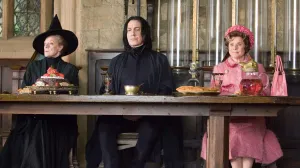With most TV series returning to the air at some point this month, and a handful of midseason shows set topremiere, there’s a lot of hurry up-and-wait going on for TV audiences.
Videos by ComicBook.com
After all, even while Supergirl comes back on January 23, ushering in the rest of The CW’s DC Comics adaptations with it and welcoming Riverdale to the airwaves, that leaves three weeks from today for fans who are jonesing for new material.

Over the weekend, we shared a list of reasons why audiences should give iZombie a try, especially since you can binge the first two seasons on Netflix before the series debuts later in the spring.
Today, we’re going to take a look at another overlooked gem: Syfy’s Wynonna Earp.
The series is making appearances on a bunch of year-end Best-Of lists, and not without good reason: it’s the most criminally under-watched comic book adaptation currently on the air, based on a comic from one of the most under-read and underrated writers of the last couple of decades (Beau Smith, also of Spawn and Guy Gardner: Warrior fame).
So while there’s still time to get caught up on the series (this one isn’t streaming for free on Netflix, but you can buy it on iTunes or Amazon, or get up-to-date on the Syfy website), let’s’ take a little (slightly spoilery) stroll down the path and figure out what makes Wynonna Earp so special.
A COMPLICATED LEAD
In the comics, the first time audiences met Wynonna Earp she was mowing down a room of ghouls, and readers were left to wonder just who the hell she was and how she got so badass.
It was twenty years — until last year’s Wynonna Earp from IDW, which mirrored a lot of elements of the TV show — before we got a sense for the tragedy that shaped her and her imperfect early days with the Black Badge Division.

And while Wynonna Earp as a series of miniseries has always been really enjoyable, it’s arguable that the 2016 series is Beau Smith’s best writing yet on the character.
So it’s nice to see that aspect of the character mirrored in the TV series. Instead of getting a wish-fulfillment female badass a la Alex Danvers, we get somebody who’s destined for greatness, but still finding her way.
She’s also a shallow alcoholic with a record, whose earliest encounters with the evil spirits she and her sister have to take on weekly left her committed to a mental institution.
Still, she’s got a sense of humor, enough snark to make her a Han Solo-type, and enough charisma to believably seduce the most beloved young man in a small town in the pilot without it seeming too trite or exploitative.
WAVERLY
One of the things added to the TV series and not present in Smith’s comic books was the character of Waverly Earp, Wynonna’s younger sister.
And she’s amazing.

Part of it is that Dominique Provost-Chalkley challenges actors like Rahul Kohli and Carlos Valdes in the realm of playing the enthusiastic sidekick-slash-zen master with such aplomb that you can’t help but fall a little in love with both the character and the actor behind it.
Part of it is, that characterization is so sterling that it might not be as great in the hands of another actor, but it would still likely be pretty great.
As the season progressed, Waverly’s character changed and deepened as much as Wynonna’s — probably more — and entered into an unexpected romance that turned the shipper community around this show into a phenomenon all its own.
A STRANGE AND BEAUTIFUL MYTHOLOGY
Did you know Doc Holliday is in this show?
In a show that leans heavily on the Old West mythology of Wyatt Earp, his best-known friend and deputy Doc Holliday shows up to make himself a part of the action.

And, no, not a descendent of Doc Hollidays, a la Wynonna and Waverly Earp. Doc Holliday — the one and only — had been trapped down a well for a century when he showed up to offer his services to the Earp family once again.
It’s just one small part of a sprawling mythology that center on a “curse” on the Earp family and ties to the supernatural nature of Wyatt Earp’s famed Peacemaker pistol. It’s that mythology which drives much of the story, and the ways that it tweaks aspects of the comic book story, aspects of real history, and wholly original material makes it a fun, cool, and immersive backstory for the characters.
ALL THE RIGHT MOVES
The creative decisions that the show makes are pretty uniformly terrific.
As noted, the character of Waverly is a new addition for the TV series. It’s one of those things where every time the show decides what to keep from the comics, and every time they decide where to stray, they seem to make a decision that suits the show perfectly and makes the story better (at least for the TV medium).

Beau Smith, actually, was coincidentally on the same page as the showrunners before he ever got a treatment for the show.
“It ended up being a collaboration that we did not plan, but it just naturally happened,” Smith told Comicbook.com. “I had always written Wynonna at the peak of her career — she was 35 to 40 years old — and there’s not a lot of female characters who are written in that age group [in comics]….But the series itself, of course I want anybody who’s never seen read the comics themselves and has only seen the television show to pick it up and feel at home. At the same time, I want respect for all the readers who have read Wynonna Earp since 1996 to also feel like it’s still their character….I want to do Wynonna Earp at the age of 27 instead of 35 or 40, and this is before she became the composed character that she has been in the series before. This is when she was reckless, this is when she first became a part of the Black Badge Division and how this all came about. And by the stars being aligned, that’s what [showrunner Emily Andras] had planned for the wider audience of the TV series.”
THE LOOK OF THE SERIES
More than probably any other comic book TV series outside of Netflix, Wynonna Earp has a cool, distinctive look.
It’s a bit reminiscent of Constantine, which is likely no coincidence since that series also blended elements of the supernatural with traditional mystery and adventure stories, and was also produced in part by Syfy’s parent company, NBC Universal, but it’s ultimately very visually distinct from anything else that’s on TV right now — in a good way.

In spite of what’s pretty clearly not a Supergirl-level budget for effects, the showrunners seem to have figured out a way to create a modest library of cool ideas and to use them consistently enough that as the season went on last year, it all felt natural rather than repetitive.
The fact that it’s such a charater- and atmosphere-driven show doesn’t hurt any, becuase it means you’re paying as much attention to the authentically Western feel of Purgatory as you are to the sometimes-iffy CG.








